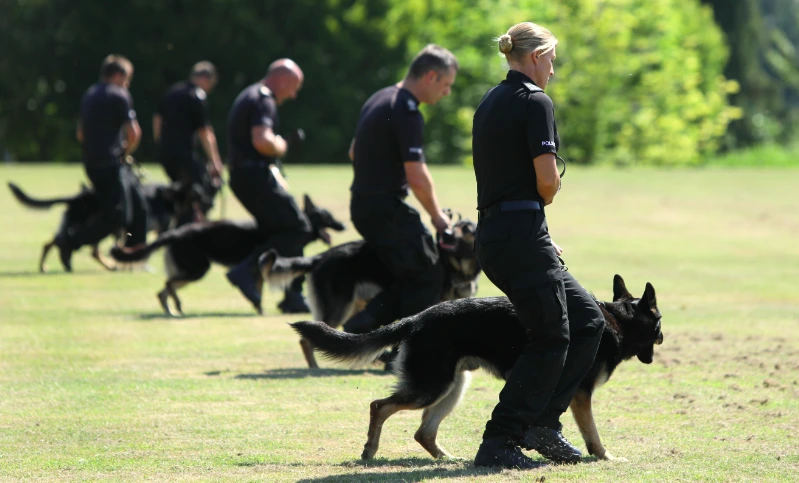Police dogs, also called K9s, play an important role in law enforcement across the world. These highly trained canine partners assist officers in various tasks, from sniffing out drugs and explosives to apprehending suspects.
In this article, we will delve into the fascinating world of how police dogs are trained, providing you with a detailed understanding of their rigorous training process.
Step 1: The Selection Process
Before a dog becomes a member of a police force, a rigorous selection process takes place. Law enforcement agencies carefully choose dogs that exhibit specific traits essential for police work.
These traits include intelligence, obedience, courage, and a strong sense of smell.
Breeds Preferred for Police Work: German Shepherds, Belgian Malinois, and Dutch Shepherds are among the preferred breeds due to their intelligence and physical capabilities.
Temperament Assessment: Dogs undergo temperament tests to evaluate their suitability for the job.
Aggressiveness towards humans is undesirable, while a strong protective instinct is valued.
Health Screening: Comprehensive medical examinations ensure the dog is in top physical condition.
Step 2: Basic Training
Once selected, police dogs go through extensive basic training to instill essential obedience and discipline.
Obedience Commands: Dogs are taught basic commands such as sit, stay, and heel. This foundation is crucial for their safety and effectiveness.
Socialization: K9s interact with various people and environments to develop confidence and adaptability.
Agility and Physical Fitness: Fitness routines help build endurance and strength, preparing the dogs for physically demanding tasks.
Step 3: Specialized Training
After basic training, police dogs receive specialized training tailored to their intended roles. Here are some common specializations:
Drug Detection: Dogs are trained to detect narcotics by recognizing specific scents. They help law enforcement agencies combat drug trafficking.
Explosive Detection: K9s can detect explosives in airports, public events, and government facilities, enhancing security measures.
Search and Rescue: These dogs are trained to locate missing persons, even in disaster-stricken areas, where their keen sense of smell is invaluable.
Step 4: Bite Work and Apprehension
A critical aspect of police dog training involves teaching the dog how to apprehend suspects safely and effectively.

Bite Training: Dogs are taught to bite and hold a suspect without causing severe injury.
Handler Control: Handlers learn how to control their dogs during high-stress situations to ensure the safety of both officers and suspects.
Protection Skills: Police dogs must be willing to protect their handlers when necessary, often serving as a visible deterrent to potential threats.
Step 5: Ongoing Training and Certification
Police dogs and their handlers engage in continuous training to maintain and improve their skills. Regular certification tests ensure that they meet the highest standards.
Mock Scenarios: Dogs and handlers practice real-life scenarios, sharpening their response to various situations.
Legal Knowledge: Handlers must stay informed about relevant laws and regulations concerning the use of police dogs.
Regular Health Check-ups: Canine health is of utmost importance, and routine veterinary visits are essential.
Success Stories and Statistics
To better understand the significance of police dogs, let’s look at some success stories and statistics:
Drug Seizures: In 2020, police K9s in the United States helped seize over $120 million worth of illegal drugs.
Missing Persons: Search and rescue dogs have played pivotal roles in locating missing individuals, especially during natural disasters.
Apprehension Success: Police dogs contribute to the successful apprehension of suspects in numerous cases, protecting officers and the public.
The Bond Between Handlers and Dogs
The relationship between a handler and their police dog is one of trust and loyalty. These pairs work closely together, often forming unbreakable bonds that extend beyond the job.

24/7 Companionship: Handlers and their K9 partners spend most of their time together, fostering a deep connection.
Emotional Support: Police dogs provide emotional support to their handlers, helping them cope with the stresses of the job.
Conclusion
Police dogs are true heroes in law enforcement, serving alongside officers to protect and serve communities.
Their training, selection process, and ongoing dedication are essential components of their success.
The bond between these K9s and their handlers demonstrates the unique partnership that makes our world safer every day.
You can explore further information on RSPCA or ASPCA related to your pet.
People Also Reads:
- Dog foods and nutrition to keep your doggy healthy
- Common dog health issues and care
- Master the art of dog grooming with these hacks
- What are the different types of dog breeds
FAQs
Q1: What are the key skills police dogs are trained to have?
Police dogs are trained in various skills, including tracking, scent detection, apprehension, and obedience. These skills are crucial for their roles in law enforcement.
Q2: How long does it take to train a police dog for duty?
The training period varies but typically lasts between 4 to 6 months. However, it can extend to a year or more for specialized tasks.
Q3: Do all police dogs go through the same training process?
No, training programs are tailored to each dog's abilities and the specific tasks they will perform. Not all police dogs receive the same training.
Q4: Are police dog training methods humane and ethical?
Yes, modern police dog training focuses on positive reinforcement and humane methods. Animal welfare is a top priority in their training.
Q5: an police dogs switch handlers during their careers?
Yes, it's possible for police dogs to change handlers, especially if the original handler retires or transfers. Dogs can adapt to working with new handlers through proper training and bonding.
